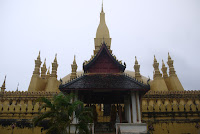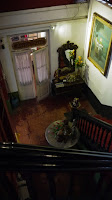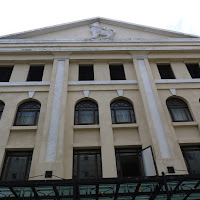Since I only had a week, I only had enough time to visit two places-Vientiane and Luang Prabang. I researched that the transportation wasn't as good to travel within the country since there is no national railway system so the only way to travel is by air or bus. There was a high risk of delays due to the muddy roads from the rainy season. I didn't want to risk delays so I booked a flight from Vientiane to Luang Prabang before traveling to Laos so I could visit those two main places.
Vientiane
The capital of Laos is rather walkable city since most temples, restaurants, and cafes are at the city center. Some sites it's best to hire a tuk-tuk. The capital is still at its developing stages as there are no high rises, large malls, main downtown area, or floods of tourists. It is a good thing that all of this hasn't happened to preserve it's local culture and historic sites, but I felt it was needed to encourage investment and modernization in the capital.
There are 3 main sites in Vientiane to visit in the city.
1. Pha That Luang ("Great Stupa"):
This sacred is the national symbol of Laos as it is the most venerated Buddhist temples. The holy site was founded long ago in the 3rd century as a Hindu temple and has witnessed numerous reconstructions throughout the centuries. The present Buddhist temple was established when the royal capital was moved to Vientiane from Luang Prabang in the 16th century. It is a rather simple shrine enclosed by a rectangular stone wall. The main stupa rises as a pinnacle and is surrounded by shorter spires on its sides. The whole structure is covered with golden paint. If you step close you can spot signs of aging as weathering has taken a toll on it. It was nice and quiet since I went late in the afternoon and only local monks were there singing. It was the simplest yet majestic of the temples I saw in Vientiane.


2. Patauxai ("Victory Gate):
This arch was completed in 1968 as a war monument to fallen Laotians during the independence movement from France. It is a Laotian designed arch some say distantly resembling the Arc de Triomphe in France. It is located on a long straight road that leads to Pha That Luang from the city center. For a small fee, you can climb atop and have a spectacular view of the city from all 4 sides. It is definitely worth the trip just for the view alone. As one of the major symbols of the city, it was a truly impressive modern marvel with its intricate carvings of European style with Laotian religious symbols and history.


3. Wat Si Siket
The oldest surviving temple in Vientiane. It was the most impressive in my opinion due to it's preservation and religious iconography. It was raining the day I visited so not many visitors were there and I couldn't get an ideal photo shot, but it was still an interesting visit. This temple complex was built in 1818. Although not as ancient as those in the older capital Luang Prabang, it was quite impressive. It consists of a large walled courtyard with a main temple. It's yellow and red painted pillars and walls made it stand out despite the dark and overcast sky. The inner walls surrounding the temple are lined with numerous buddhist statues in different styles from different ages. Some look like they are older than the temple itself. It reminded me of Wat Po in Bangkok where the courtyard is similarly decorated.



Other sites in Vientiane I visited were:
That Dam (Black Stupa)
This crumbling stupa shows the scars of being desecrated and stripped of it's gold coating from the Siamese suppression of Lao independence rebels in 1827. It is off the main city center and tourist roads but is a good remnant of Lao history. There is a small grassy park that surrounds the site. When I visited, I didn't see anyone else so it was nice to stroll around the structure.

Wat Inpeng
This temple is at the center of the town and often visited due to its location and proximity to hotels, hostels, restaurants, and bars. It was vibrantly decorated with buddhist mythological symbols, animals, warriors, and royalty. Most of the temples downtown are free (except Wat Si Saket) so its nice to wander around and marvel at the Lao architecture.

Lao National Museum
Housed in an old French colonial building, the exterior retains its former grandeur. There are trees and flowers surrounding the museum building. Inside, there are relics from its ancient and classical periods. There is also a big section on modern communist influences in Laos and SE Asia. Not as impressive or extensive as I thought, but it was nice to see some relics from Lao culture and history.
Presidential Palace
The palace is a gray and white painted mega structure that is fitting for the head of state. It is gated with black iron bars and makes for a good photo shoot from it's front. Unfortunately, it's closed to the public so you can only take a picture of it and move on. It isn't as heavily guarded as other presidential palaces I've visited, but there aren't many tourists nearby it so there is probably not a need.
Food
Whenever I travel, I make sure to research good local delicacies and restaurants so I could sample the local cuisine. It's the best way to immerse yourself in the culture and history.
Traveler tip: Don't be afraid to take risks in trying street food, it is usually the cheapest and tastiest. Avoid ones with few or no people. Try to go to the ones with long lines as you know the turnover rate is high therefore the food is fresh. Just use your common sense in judging the hygiene of the food stall before purchasing.
During my stay in Vientiane I tried the following:
Joma Bakery and Cafe:
Dragon fruit and pineapple shake
 |
Lao Kitchen:
Fried Mekong Fish, Sticky Rice, Morning Glory, and Beer Lao




Le Banneton Bakery and Cafe:
Full breakfast: du bacon, des oeufs, le croissant, tartine avec confiture et beurre

Local noodle shop my Airbnb host took me to:
rice noodles with garlic, onions, bean sprouts, chicharon, fried bread & fresh coconut juice


Fried donuts and sweets, yogurt dessert; and Vietnamese spring rolls


My next post will be on the rest of my trip which was in Luang Prabang. I was there for a longer period so I felt I saw and experienced everything.
Subscribe to my instagram: joelglobetrotter
Thanks for your support!!^^








































































